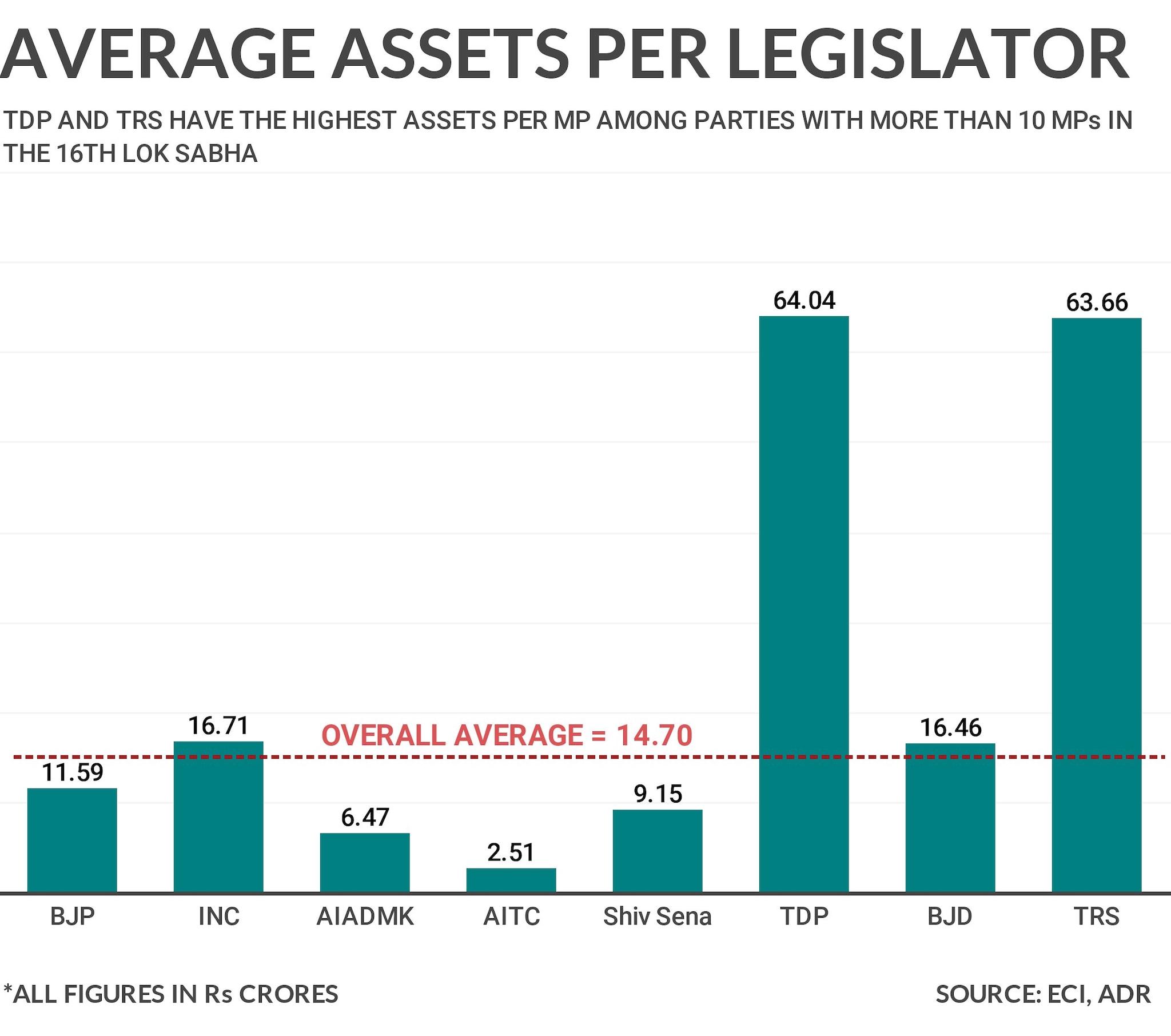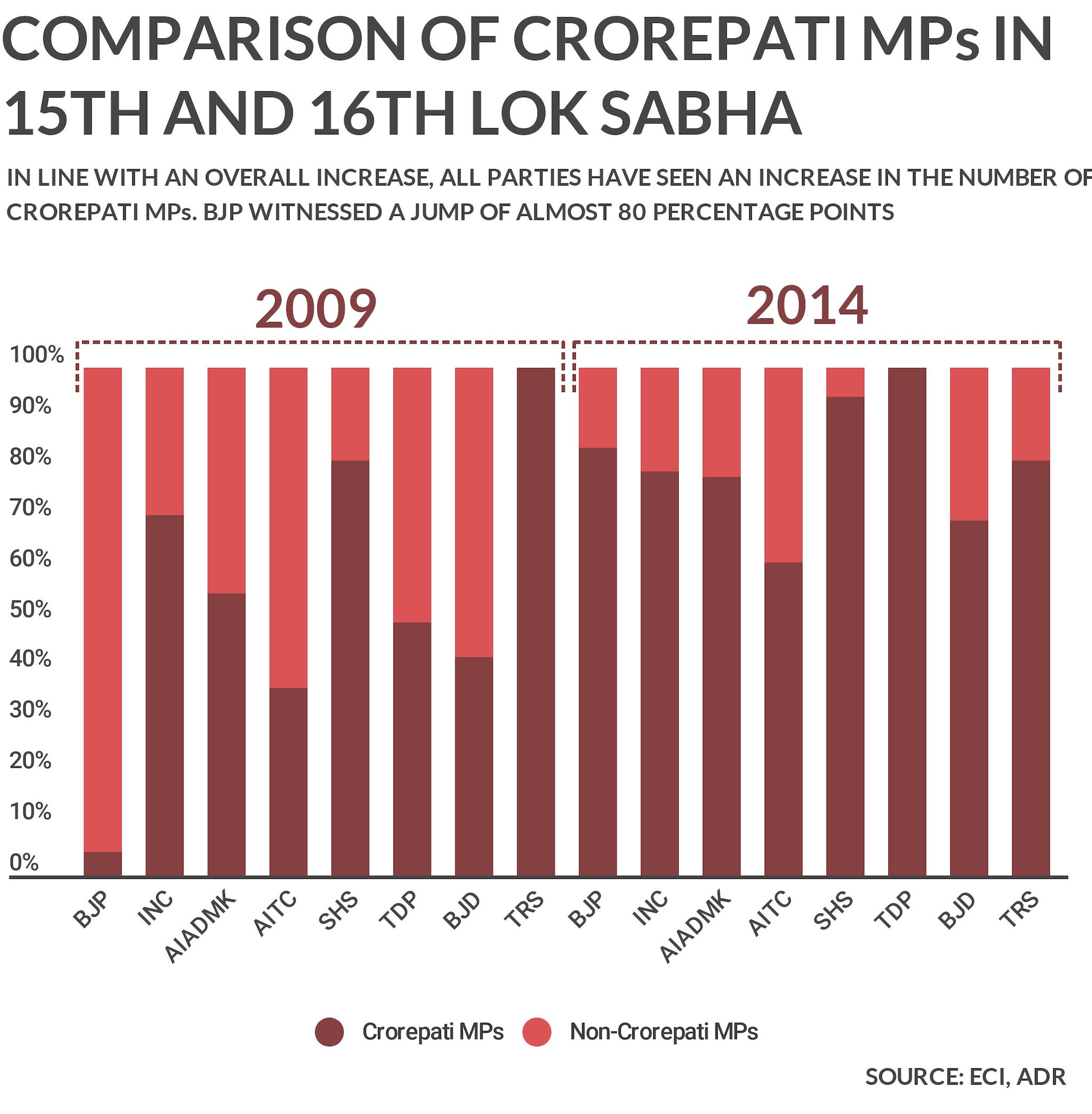The total amount spent in elections rose from Rs 269 crores in 2004 to Rs 1308 crores in 2014. As elections have become expensive, more and more candidates with high net assets have joined the fray over the years.
Winning an election in India requires some serious investment. In the first part of this series, News18 looked at the way candidates and parties spend crores of rupees during elections in each constituency. But for obvious reasons, not every a party can afford to splurge that much money on a candidate. That’s where one comes across another important aspect of the Great Indian Election: Crorepati candidates.
According to a News18.com analysis, the six recognised national parties in the country (BJP, INC, NCP, BSP, CPI, CPM) saw a 386 per cent increase in election expenditure between 2004 and 2014. The total amount spent rose from Rs 269 crores in 2004 to Rs 1308 crores in 2014. As elections have become expensive, more and more candidates with high net assets have joined the fray over the years.
In Lok Sabha 2009 elections, 1,212 (16 per cent) of the 7,669 contesting candidates were crorepatis. This number increased to 2,217 (27 per cent) out of 8,205 candidates in Lok Sabha elections of 2014.
But it is not without reason that almost all political parties are fielding more candidates with high net worth. Data suggests that a crorepati candidate has a better shot at power than a candidate who has assets worth less than a crore of rupees.
The ratio of total crorepati candidates contesting candidates and those who eventually succeed shows that a crorepati candidate has a 20 per cent chance of winning an election. The same analysis also gives a success rate of two per cent for candidates with low assets.
This higher probability of a richer candidate winning against a comparatively poorer candidate is evident in the number of MPs that finally made it to the parliament in 2014.
Nearly 82 per cent or 443 out of the total 542 MPs who emerge victorious were crorepatis in the 16th Lok Sabha polls. Meanwhile, only 58 per cent of the MPs were crorepatis in the 15th Lok Sabha 2009.
Even among two candidates of the same party, the chances of coming to power varies based on the candidates’ net worth. So, for instance, while a crorepati BJP MP has a 77 per cent chance of winning the election, the chances of a non-crorepati candidate winning are exactly half of that.
That is why many political parties induct candidates with hefty amount of assets.
According to Sanjay Kumar of Centre for the Study of Developing Societies (CSDS), “Many parties don’t give tickets to people who don’t have the capacity to spend money.”
“This,” Kumar explains, “is because the party cannot give money to a lot of candidates for fighting elections as they have their own limits. Rather, it is the other way round. Parties think of those candidates who may be able to help the party because most of the expenditure is incurred by the candidate and not by the party.”
A larger share of high net worth MPs in total, also reflects in individual parties. Almost 84 per cent of the BJP MPs have declared assets worth more than Rs 1 crore. Similarly, 80 per cent of the Congress MPs, too, are crorepatis.
According to Kumar, “Ninety percent of the candidates are crorepatis and someone having Rs 10 crore or say Rs 50 crore has way higher chances of winning the elections than somebody who has Rs 1 crore. Similarly, somebody who has a crore has more chances of winning someone who doesn’t because it costs to contest elections in India.”
There are, however, exceptions to this.
An election observer, who works for an election management company, and wished to remain anonymous, explained this.
“Last year a farmer leader contested and won elections in Maharashtra. That is because he was an influencer and had become famous after a farmer rally. So he did not need a lot of money. He had already built a brand around himself,” the analyst said.
But where does most of the money go, apart from campaigning and publicity?
Jayprakash Narayan of the Lok Jansatta Party hints it is used for vote buying.
“In many villages across the country, people demonstrate saying that we will not participate in elections because they say nobody has come to our village to distribute money,” Narayan told News18.com.
He further explained the per capita cost incurred for Lok Sabha elections is much lower than the Assembly elections.
“It is a simple game of supply and demand. See, in a panchayat or a municipality, when the elections is tight, per vote is much much higher, though the power is not there with a municipality. Whereas, when you to Lok Sabha where you have ten fifteen lakh votes, you cannot spend that amount so there will be less money spent per vote in terms of vote buying. This is why regional parties spend more in assembly elections vis-à-vis national parties,” Narayan said.
But this amount of money moolah doesn’t apply to national parties only.
In terms of average assets of MPs, TDP and TRS are significantly ahead of other parties with Rs 64 crore and 63 crore worth of individual assets, hence the reason behind all of the 42 MPs of the undivided Andhra Pradesh being crorepatis.
Not surprisingly, all the three legislators having the highest assets are from the Telugu region. This includes Jayadev Galla (Rs 683 crores) of TDP from Andhra Pradesh, Konda Vishweshwar Reddy (Rs 583 crores) of TRS from Telangana and Gokaraju Ganga Raju (Rs 288 crores) of BJP from Andhra Pradesh.
The three lawmakers with the lowest amount of assets are: Sumedha Nand Saraswati (Rs 34,000) and Mahant Chand Nath Yogi (Rs 1.99 lakhs) of BJP from Rajasthan and Uma Saren (Rs 4.99 lakhs) of Trinamool Congress (AITC) from West Bengal.
State-wise, 85 per cent from Uttar Pradesh, 94 per cent from Maharashtra and 93 per cent of the MPs from Karnataka have declared assets worth more than one crore rupees.



